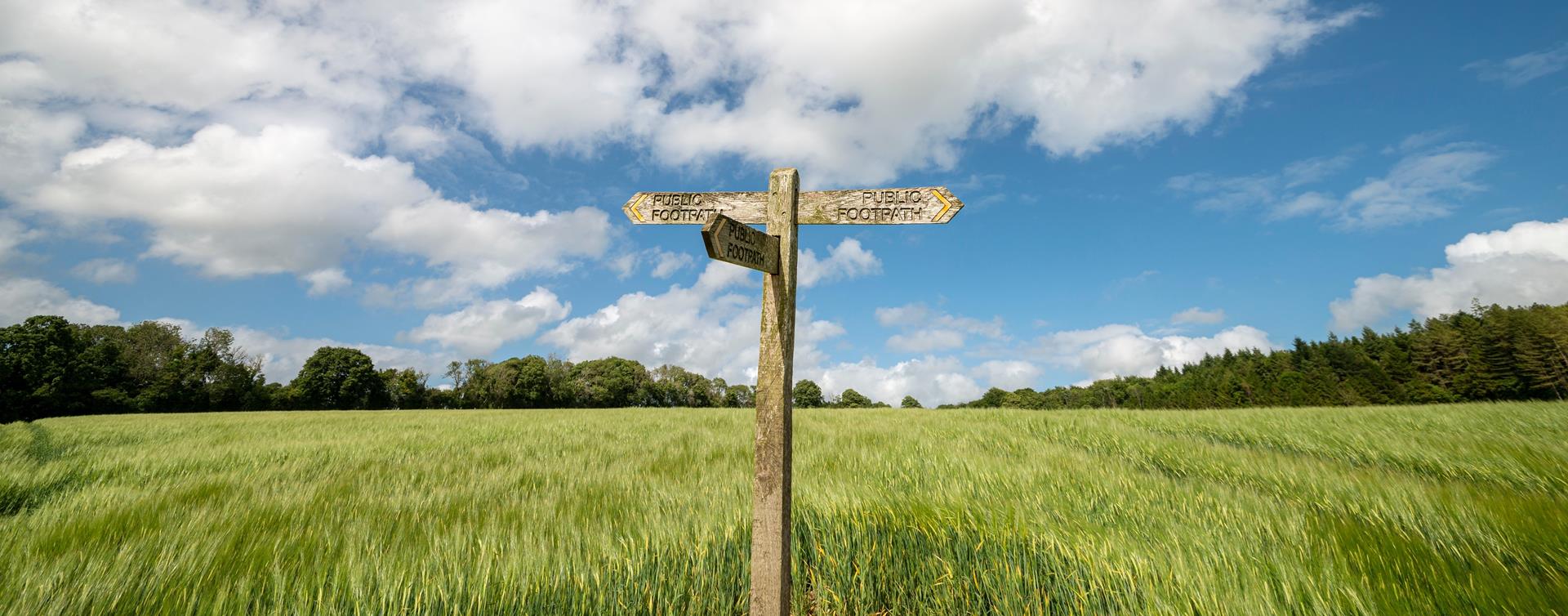
The Right to Roam: Public Rights of Way in the UK
Mon 30 Jan 2023
We see them signposted, use them, and often take them for granted. With a focus from the Government for increased public access to the Countryside - what are public rights of ways, how may one be introduced and how might you prevent their creation?
What is a Public Right of Way?
A public right of way is a right by which the public can pass along linear routes over land at all times. Although the land may be owned by a private individual, the public have a legal right across that land along a specific route.
They are all highways in law, but the term ‘public rights of way’ is generally used to cover more minor highways. The mode of transport allowed differs according to what type of public right of way it is. There are four classifications:
- Footpaths: a highway over which the public has a right of way on foot only
- Bridleways: a highway over which the public has a right of way on foot, horseback and on a pedal cycle (including mountain-bikes). There may also be a right to drive animals along a bridleway.
- Restricted Byways: a highway over which the public is entitled to travel on foot, horseback and with non-mechanically propelled vehicles (such as pedal cycles and horse-drawn vehicles). There may also be a right to drive animals along a restricted byway
- Byways Open to All Traffic (BOATS): a highway over which the public is entitled to travel on foot, horseback or pedal cycle and by wheeled vehicles of all kinds, including mechanically propelled vehicles, but which is used by the public mainly for walking or for riding. For example, a ‘green lane’ is a BOAT.
How you use a right of way is important. You may only make a bona fide journey with reasonable rest along the way.

A restricted byway can be used by pedestrians, horse-riders and non-motorised vehicles
How are Public Rights of Way Recorded?
A record is kept by the local Highway Authorities of the status of the public right of way and its classification (footpath, bridleway etc).
Some Local Authorities are also ‘Surveying Authorities’ and are tasked with recording public rights of way on maps known as Definitive Maps; a legal record (at the date of the map) of the existence of that right of way. Local Authorities have a duty to ensure that such rights of way are maintained and remain useable. Ordnance Survey use this information when compiling their OS maps.
Definitive Maps are accompanied by a Definitive Statement which describes in detail each right of way, noting for example details of the width of the right of way or any restrictions or limitations affecting it.
These are public documents that you can usually view at your local Council Offices.
Is the Definitive Map definitive?
No. In practice not all Definitive Maps are definitive. They were thought to be accurate at the time they were created but historic routes may exist which are unrecorded, routes may have been recorded in the wrong place or at the wrong status, routes may have been recorded which are not public rights of way and new routes may have come into existence through a qualifying public use.
How new Public Rights of Way are created?
Simply put, if a way/route over land has been enjoyed by the public without interruption for a full period of 20 years, the way is deemed to have been dedicated as a highway unless there is sufficient evidence that there was no intention during that period to dedicate it.
For a way to qualify it must be 'as of right'; this means used without secrecy, force, or permission.
How can I prevent the Creation of a Public Right of Way?
Rights of Way need to be evidenced by those trying to create them, so it is wise as a landowner to establish a lack of intention to create any rights by evidencing your intentions not to create a right of way. For example:
- Erecting notices
- Fencing the land
- Locking gates
These methods are not fool proof so the prudent landowner might:
- Agree to provide access by permission - a Permissive Path is an unofficial right of way provided by landowners that can be documented and declared to the Local Authority.
- Use the legal procedure set out in Section 31 (6) of the Highways Act 1980 to deposit a map, statement and declaration with the Local Authority showing existing public rights of way and confirming no further rights are intended to be dedicated.

A wide, open bridleway between a landowner's two fields
How can Brown & Co help?
Our Land Agents can prepare and lodge Section 31 (6) deposits and Permissive Path Agreements for landowners to give you peace of mind that no new right of way can be established on your land without your permission. At the same time, we can advise on how to prevent land being registered as a town or village green.
For more details please contact Hannah Skingley, Divisional Partner and Land Agent at our St Neots office on 01480 598865. You can also find out about the other Estate Management services Brown&Co can provide by clicking below.
Keep updated
Keep up-to-date with our latest news and updates. Sign up below and we'll add you to our mailing list.
 Brown&Co
Brown&Co
